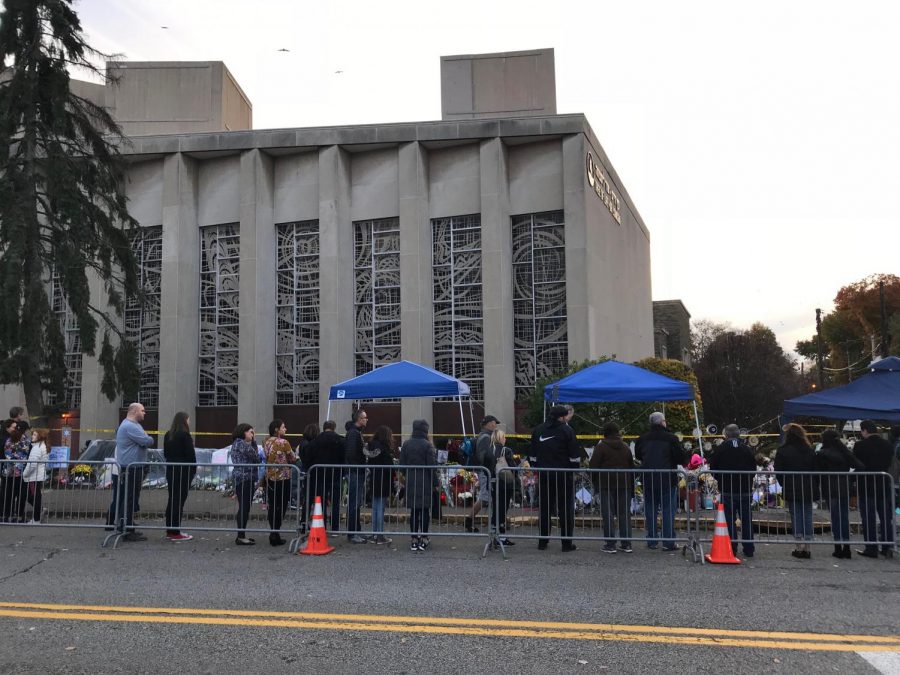Violence against Jews stems from troubling normalization of anti-semitism
Of the two recent instances of high-profile religious violence committed in America, the Apr. 27 Poway shooting and the October 2018 Tree of Life shooting, both have one chilling characteristic in common: both are synagogues, places of worship for the Jewish faith.
Any discussion of religious violence must be accompanied by an ugly truth in America: anti-semitism hangs like a weight over our current culture, and it is not necessarily isolated to acts of violence. Questionable rhetoric by politicians and major publications has created a need to address the many ways anti-semitism manifests itself in American society.
In the Poway shooting, the suspect’s anti-semitism was not only overt, but palpable. In a letter posted online prior to the shooting, the suspect expressed multiple anti-Semitic and white nationalist statements. The Tree of Life shooter wielded anti-Semitic slurs in social media postings (CNN). In the 2017 Charlottesville white nationalist rally, white nationalists chanted, “Jews will not replace us.”
When faced with such heinous acts and expressions of anti-Semitism, it’s easy to denounce them and stand in solidarity with Jewish people. What becomes more difficult is recognizing how anti-semitism seeps into institutions, media portrayals, and casual conversations, mirroring other forms of discrimination.
Implicit anti-semitism often reveals itself through “humor,” especially at the high school level. Jokes about the Holocaust, while generally perceived as deeply offensive, are still made on a daily basis.
“What’s also left out of holocaust education is the continuing repercussions that Jews face,” junior Alyssa Knudsen said. “A lot of people see the [Holocaust] and say ‘okay, that happened in 1945, no big deal,’ but they need to understand that the ramifications are still present today.”
In terms of ongoing ramifications, inappropriate and offensive humor at the expense of Jews doesn’t stop in school hallways. Anti-semitic humor is present even in major institutions. The New York Times recently published what many labeled a blatantly anti-Semitic cartoon, which was then promptly taken down. While The New York Times apologized and claimed that the publication of the offensive comic was the result of a lack of oversight, the worrisome example of a major, respected publication contributing to anti-semitism had already become deeply apparent.
On the political stage, anti-semitism is often a consequence of the controversy over U.S. support for Israel, a nation that was designed to be a haven for oppressed Jews fleeing genocide in Europe during and following World War II. The controversial actions of the Israeli government in recent decades, namely human rights violations against members of the neighboring country of Palestine, have fueled debate over whether the U.S. should maintain such close ties with Israel.
While the Israeli government has committed unjust actions against its Palestinian neighbors, anti-Israel politics at times contribute to rhetoric that furthers the social oppression against Jews, a majority of whom have denounced the Israeli government’s actions as unrepresentative of the Jewish faith.
“You see the blurring of the line between the Jewish identity, the ritual, and the tradition, and the government representatives who you think are acting unacceptably and oppressive,” Knudsen said.
When it comes to combating instances of anti-semitic violence, it seems clear that shutting down “unintentional” anti-semitism is the most pressing task for the average person to take on. The use of anti-semitic language by the perpetrators involved in religiously motivated attacks is not simply derived from small, niche communities of bigots. “Harmless” or “misinterpreted” statements by mainstream society, including those in power, have enabled a culture that often trivializes anti-semitism in its most widespread form.

Shawna Muckle, 17, is a senior at Jesuit High School. She has been a member of the Chronicle staff for three years in various capacities, and she is currently one of its chief editors. Shawna is fascinated by politics and government, and she enjoys writing articles for the Chronicle pertaining to local and national political developments, alongside issues tied to social justice and personal identity. Some of her favorite pieces she’s written include a feature on Jesuit students’ experience with microaggressions, a recap of the 2018 midterm elections, and an article discussing last year’s clerical abuse scandal within the Catholic Church. Outside of journalism, Shawna is the leader of Jesuit’s Model United Nations club and a member of her school’s Ethics Bowl team, which was a 2019 national champion. Shawna is also a Precinct Committee Person for the Washington County Democrats. In her free time, Shawna can be found aggressively running up hills, drinking boba, and yeeting off on road trips to Seattle (for unspecified reasons). Ask her about her opinions on Congress, specifically a) Republicans and b) the crisis with the federal deficit. In the future, Shawna hopes to pursue journalism in college and, later on, as a congressional reporter in DC.



